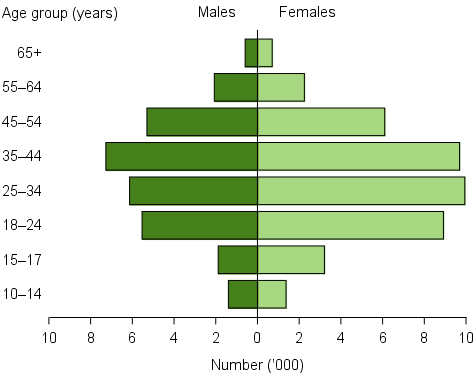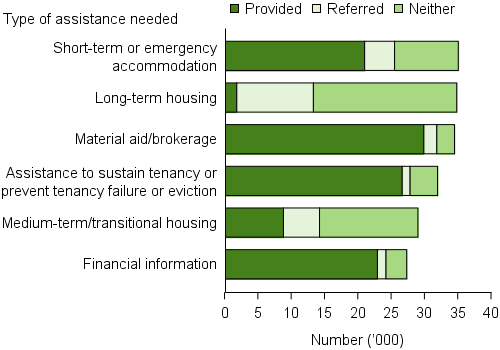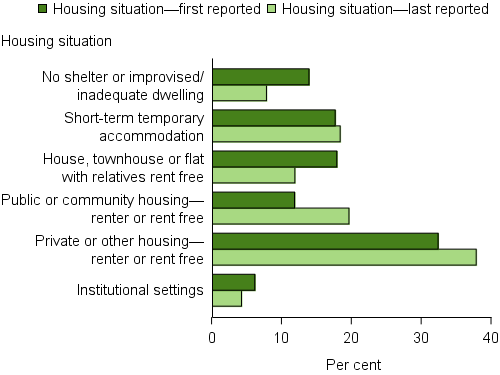Clients with a current mental health issue
In 2015–16, over 1 in 4 clients, or an estimated 72,000 people, who received assistance from a specialist homelessness agency were identified as having a current mental health issue, 9,300 (15%) more than in 2014–15.
Key findings in 2015–16
- The number of clients with a current mental health issue increased 15% from the previous year to over 72,000; this growth rate was higher than that of the general SHS population (9%).
- 1 in 4 (26%) needed assistance because of a 'housing crisis' and most were living alone (46%) when they sought assistance.
- 1 in 2 clients (50%) were homeless when they approached a SHS agency, most living either in short-term or emergency accommodation (18%) or 'couch surfing' (18%).
- Housing outcomes improved: Fewer clients were homeless following support (38%), with 'rough sleepers' dropping 6 percentage points to about 3,500 at the end of support. The largest improvement in housing situation was for clients in public and community housing—up from 12% at the start of support to 20% at the end of support.
Clients with a current mental health issue: 2011–12 to 2015–16
Increasing numbers of clients with mental health issues
have been supported by homelessness agencies between 2011–12 and 2015–16, growing at an average rate of 13% per year.
The number of clients presenting with a current mental health issue has been increasing since the beginning of the SHS collection in 2011–12. Key trends identified over the 5 years to 2015–16 have been:
- Clients with a current mental health issue are the fastest growing client group within the SHS population, growing at an average rate of 13% per year since 2011–12. Factors, including increased identification, community awareness and reduced stigma have all potentially driven the increase in self-identification and reporting of mental illness among SHS clients.
- The rate of service use has increased from 20 people per 10,000 population to 30 people in 5 years (Table MH Trends.1).
- These clients consistently need longer periods of support and tend to return more often for support within the 12 month reporting period than any of the other client priority groups.
- 'Housing crisis' and 'domestic and family violence' remain the most common main reasons these clients seek assistance from specialist homelessness agencies.
| 2011–12 | 2012–13 | 2013–14 | 2014–15 | 2015–16 | |
|---|---|---|---|---|---|
| Number of clients (proportion of all clients) | 44,835 (19) | 48,599 (20) | 56,281 (22) | 63,062 (25) | 72,364 (26) |
| Rate (per 10,000 population) | 20.1 | 21.4 | 24.3 | 26.9 | 30.4 |
| Housing situation at the beginning of first support period (proportion of all clients) | |||||
| Homeless | 49 | 51 | 50 | 50 | 50 |
| At risk of homelessness | 51 | 49 | 50 | 50 | 50 |
| Length of support (median number of days) | 67 | 73 | 67 | 62 | 64 |
| Average number of support periods per client | 2.2 | 2.4 | 2.3 | 2.3 | 2.3 |
| Proportion receiving accommodation | 49 | 48 | 44 | 42 | 39 |
| Median number of nights accommodated | 49 | 48 | 48 | 44 | 44 |
| Proportion of a client group with a case management plan | 71 | 69 | 69 | 70 | 70 |
| Achievement of all cases management goals (per cent) | 14 | 15 | 18 | 19 | 17 |
Notes
- Rates are crude rates based on the Australian estimated resident population (ERP) at 30 June of the reference year.
- The denominator for the proportion achieving all case management goals is the number of client groups with a case management plan. Denominator values for proportions are provided in the relevant national supplementary table.
- Indicates where previously published data have been revised to ensure consistent reporting.
Source: Specialist Homelessness Services Collection 2011–12 to 2015–16.
Clients with a current mental health issue 2015–16
In 2015–16, 1 in 4 (26% or 72,364) clients accessing specialist homelessness services identified experiencing a current mental health issue:
- Half (50%) were homeless when they presented to an agency, higher than the general SHS population (44%) and most commonly lived alone (46% compared with 29%, respectively).
- These clients came back more often than any other priority group for support during the year (2.3 support periods per client) and received a median of 64 days of support each time. By comparison, the general SHS client population received 1.7 support periods and 35 days of support each time.
Age and sex
Similar to the general SHS population, the majority of clients with a current mental health issue were female (58%) in 2015–16. However, unlike the general SHS population nearly half of all clients with a current mental health issue were aged between 25 and 44 (46% compared with 37% in the general SHS population) (Figure MH.1).
Figure MH.1: Clients with a current mental health issue, by age and sex, 2015–16

Source: Specialist Homelessness Services 2015–16, National Supplementary Table MH.1.
Services needed and provided
About 35,000
or just under half of the clients experiencing a current mental health issue (48%) needed short-term or emergency accommodation; 60% of these clients were provided assistance.
Of those clients experiencing a current mental health issue, about 1 in 3 (31%, or 22,000) identified a need for mental health-based services with:
- 26% identifying a need for mental health services; 47% of these requests were met.
- 11% identifying a need for psychological services; 36% of these requests were met.
- 7% identifying a need for psychiatric services; 40% of these requests were met.
Compared with the general SHS population, clients experiencing a current mental health issue were more likely to identify a need for:
- drug and alcohol services (10% compared with 4% of the general SHS population).
- health/medical services (21% compared with 10%).
- Accommodation services (69% compared with 56%) and in particular long-term housing (48% compared with 34%) and medium-term/transitional housing (40% compared with 27%).
Clients experiencing a current mental health issue also identified needing:
- material aid/brokerage (48% or nearly 35,000 clients); with assistance able to be provided to 87% of these clients
- financial information (38% or over 27,000 clients); with assistance able to be provided to 84% of these clients
- transport (33%); with assistance able to be provided to 93% of these clients (Figure MH.2)
- assertive outreach (27%, or nearly 20,000), which mostly targets rough sleepers; this was higher for those clients with a current mental health issue than other priority groups.
All these services were needed at higher rates than the general SHS population (material aid/brokerage 35%, financial information 25%, transport 22%, assertive outreach 18%).
Figure MH.2: Clients with a current mental health issue, by top 6 most needed services and service provision status, 2015–16

Note: Excludes 'Other basic assistance', 'Advice/information', and 'Advocacy/liaison on behalf of client'.
Source: Specialist Homelessness Services 2015–16, National Supplementary Table MH.3.
Housing outcomes
For clients experiencing a current mental health issue and whose support had ended:
- Half (50%, or nearly 24,000) were homeless at the beginning of support, with this reducing to 38% at end of support.
- improvement in housing outcomes was particularly evident for clients who first presented 'rough sleeping', that is, having no shelter or living in an improvised/inadequate dwelling. The rough sleeping rate dropped from 14% at the commencement of support to 8% at the end of their support (Supplementary Table MH.4).
Most of these clients were housed at the end of support with (Figure MH.3):
- 38% (or around 17,000 clients) in private rental (increasing from 32% at the commencement of support).
- 20% (or nearly 9,000 clients) in public/community housing (increasing from 12% at the commencement of support).
Figure MH.3: Clients with a current mental health issue, by housing situation at the beginning and end of support, 2015–16

Notes
- The SHSC classifies clients living with no shelter or improvised/ inadequate dwelling, short-term temporary accommodation, or in a house, townhouse, or flat with relatives (rent free) as homeless. Clients living in public or community housing (renter or rent free), private or other housing (renter or rent free), or in institutional settings are classified as housed.
- Proportions include only clients with closed support at the end of the reporting period.
Source: Specialist Homelessness Services 2015–16, National Supplementary Table MH.4.


